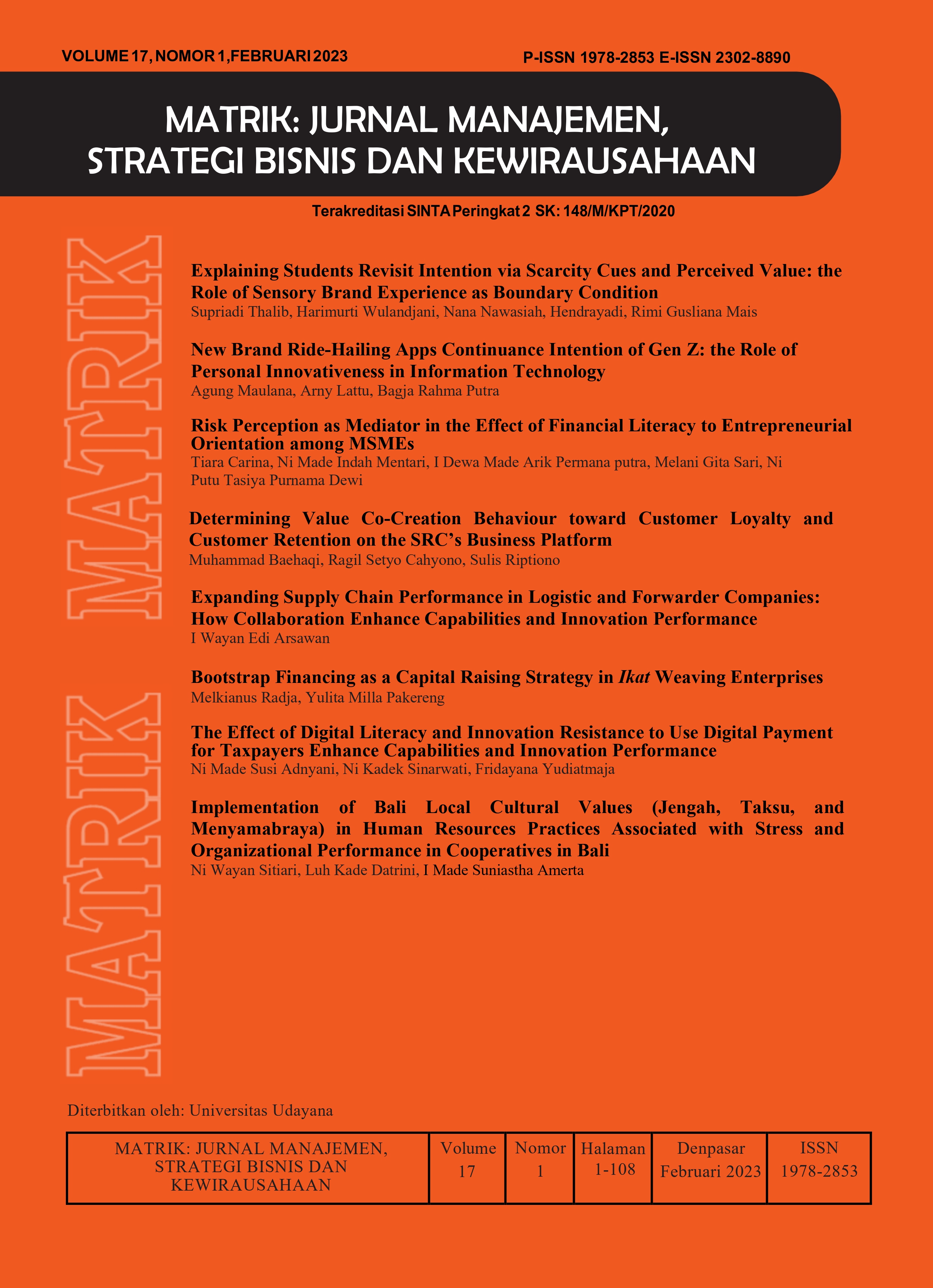Explaining Students Revisit Intention via Scarcity Cues and Perceived Value: the Role of Sensory Brand Experience as Boundary Condition
Abstract
In response to an empirical study on scarcity cues in COVID-19, the present study offers a model of the relationship between scarcity cues and revisit intention by integrating perceived value and sensory brand experiences (SBE). The moderation mediation model (MOD MED) was tested using 426 respondents who were university students in Jakarta. The results of the analysis show that scarcity cues have a negative impact on perceived value and revisit intention. The process model has been confirmed through the role of perceived value in the scarcity cues relationship. SBE in this study has an essential role as a bearing for the negative effect of scarcity cues on perceived value and revisit intention. Hence, this study offers a theoretical contribution to the proposed model and a practical one regarding the effectiveness of "scarcity cues" marketing strategies.
Keyword: Scarcity Cues, Sensory Brand Experiences, Perceived Value, Revisit Intention
Downloads
References
Brakus, J. J., Schmitt, B. H., & Zarantonello, L. (2009). Brand Experience: What is It? How is it Measured? Does it Affect Loyalty? Journal of Marketing, 73(3), 52–68. https://doi.org/10.1509/jmkg.73.3.052
Gabler, C. B., & Reynolds, K. E. (2013). Buy Now or Buy Later: The Effects of Scarcity and Discounts on Purchase Decisions. Journal of Marketing Theory and Practice, 21(4), 441–456. https://doi.org/10.2753/MTP1069-6679210407
Hair, J. F., Risher, J. J., Sarstedt, M., & Ringle, C. M. (2019). When to use and how to report the results of PLS-SEM. European Business Review, 31(1), 2–24. https://doi.org/10.1108/EBR-11-2018-0203
Han, H., Back, K.-J., & Barrett, B. (2009). Influencing factors on restaurant customers’ revisit intention: The roles of emotions and switching barriers. International Journal of Hospitality Management, 28(4), 563–572. https://doi.org/10.1016/j.ijhm.2009.03.005
Hayes, A. F. (2017). Introduction to mediation, moderation, and conditional process analysis: A regression-based approac. Guilford publications.
He, Y., & Oppewal, H. (2018). See How Much We’ve Sold Already! Effects of Displaying Sales and Stock Level Information on Consumers’ Online Product Choices. Journal of Retailing, 94(1), 45–57. https://doi.org/10.1016/j.jretai.2017.10.002
Huang, H., Liu, S. Q., Kandampully, J., & Bujisic, M. (2020). Consumer Responses to Scarcity Appeals in Online Booking. Annals of Tourism Research, 80, 102800. https://doi.org/10.1016/j.annals.2019.102800
Hwang, J., & Lee, J. (Jay). (2019). Antecedents and consequences of brand prestige of package tour in the senior tourism industry. Asia Pacific Journal of Tourism Research, 24(7), 679–695. https://doi.org/10.1080/10941665.2019.1623274
Iglesias, O., Markovic, S., & Rialp, J. (2019). How does sensory brand experience influence brand equity? Considering the roles of customer satisfaction, customer affective commitment, and employee empathy. Journal of Business Research, 96, 343–354. https://doi.org/10.1016/j.jbusres.2018.05.043
Kock, F., Berbekova, A., & Assaf, A. G. (2021). Understanding and managing the threat of common method bias: Detection, prevention and control. Tourism Management, 86, 104330. https://doi.org/10.1016/j.tourman.2021.104330
Li, Y., Yao, J., & Chen, J. (2021). The negative effect of scarcity cues on consumer purchase decisions in the hospitality industry during the COVID-19 pandemic. International Journal of Hospitality Management, 94, 102815. https://doi.org/10.1016/j.ijhm.2020.102815
Mehrabian, A., & Russell, J. . (1974). An Approach to Environmental Psychology. MIT Press.
Nazlan, N. H., Tanford, S., Raab, C., & Choi, C. (CB). (2018). The influence of scarcity cues and price bundling on menu item selection. Journal of Foodservice Business Research, 21(4), 420–439. https://doi.org/10.1080/15378020.2018.1440129
Podsakoff, P. M., MacKenzie, S. B., & Podsakoff, N. P. (2012). Sources of Method Bias in Social Science Research and Recommendations on How to Control It. Annual Review of Psychology, 63(1), 539–569. https://doi.org/10.1146/annurev-psych-120710-100452
Safeer, A. A., He, Y., & Abrar, M. (2021). The influence of brand experience on brand authenticity and brand love: an empirical study from Asian consumers’ perspective. Asia Pacific Journal of Marketing and Logistics, 33(5), 1123–1138. https://doi.org/10.1108/APJML-02-2020-0123
Sweeney, J. C., & Soutar, G. N. (2001). Consumer perceived value: The development of a multiple item scale. Journal of Retailing, 77(2), 203–220. https://doi.org/10.1016/S0022-4359(01)00041-0
Teubner, T., & Graul, A. (2020). Only one room left! How scarcity cues affect booking intentions on hospitality platforms. Electronic Commerce Research and Applications, 39, 100910. https://doi.org/10.1016/j.elerap.2019.100910
van der Westhuizen, L.-M. (2018). Brand loyalty: exploring self-brand connection and brand experience. Journal of Product & Brand Management, 27(2), 172–184. https://doi.org/10.1108/JPBM-07-2016-1281
Wu, L., & Lee, C. (2016). Limited Edition for Me and Best Seller for You: The Impact of Scarcity versus Popularity Cues on Self versus Other-Purchase Behavior. Journal of Retailing, 92(4), 486–499. https://doi.org/10.1016/j.jretai.2016.08.001
Zhang, J., Jiang, N., Turner, J. J., & Pahlevan-Sharif, S. (2022). The Impact of Scarcity on Consumers’ Impulse Buying Based on the S-O-R Theory. Frontiers in Psychology, 13. https://doi.org/10.3389/fpsyg.2022.792419
 This work is licensed under a Creative Commons Attribution-ShareAlike 4.0 International License.
This work is licensed under a Creative Commons Attribution-ShareAlike 4.0 International License.

















